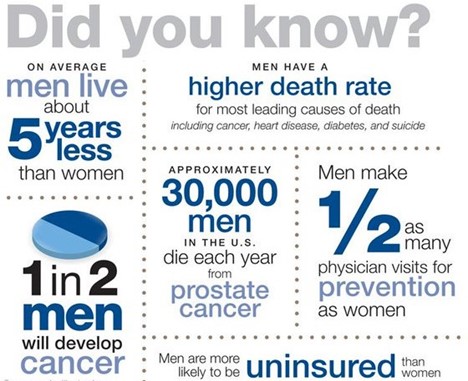Men, June means it’s time to take charge of your health!

The month of June is Men’s Health Month and is dedicated to bringing awareness and providing education regarding all things health for the male population. With chronic disease and sedentary lifestyles on the rise, it is more important than ever to stay properly informed of how you can take steps to preserve your own health. Oftentimes, it can be as simple as making small changes to your daily routines that can prevent illness and preserve your quality of life in the long run.
Leading Health Concerns and Risk Factors
While men and women both share many of the same leading causes of death, studies have shown that men have a higher morbidity and mortality rate than women from coronary heart disease, hypertension (high blood pressure), diabetes and cancer, four of the top ten leading causes of death in our country. Though many factors, including genetics, come into play with these diseases that are not always avoidable, many of the biggest risk factors are preventable, including smoking, alcohol consumption, lack of physical activity, obesity, and high-risk behavior.
Statistics have identified men as being more likely to smoke, drink higher amounts of alcohol, partake in risky behaviors, and put off checkups and medical care, all of which put you in a much higher risk category for chronic disease. Recognizing the risk factors that are most at play for you and reducing their presence in your own life can have a monumental impact on the quality of your life.

Health Issues Unique to Men
In addition to being at higher risk for universal health issues that can affect everyone, there are several health concerns that are unique to men. These include prostate cancer, benign prostate enlargement and low testosterone. Sometimes signs and symptoms don’t present themselves until it’s too late, and because men are more likely to skip the doctor visits, these diseases can go unnoticed for some time despite treatments being available. Regular checkups and screenings are imperative for men, as they can often identify disease early, even before symptoms occur, making it more likely that treatment will be successful.
Making the Change
Lifestyle changes can be hard but living with chronic disease that could have been prevented is the unfortunate alternative. When you’re ready to consider evaluating some of the risk factors for disease that exist in your own life, start by making a list. Once you’ve made a list, pick one to three things that you can change right away. The change can be as small as drinking one more cup of water each day to as big as hiring a personal trainer or nutrition coach!
Remember, a huge key to success is starting with something you know you will be able to stick to in order to build a strong habit. Reducing risk factors, improving your nutritional choices, and increasing your daily activity levels has a long list of benefits. These include better sleep, improved cognition, less weight gain, decreased levels of depression, and lower risk of heart disease, stroke, type-II diabetes, hypertension, Alzheimer’s and several types of cancers. You have the ability to dictate your quality of life for the rest of your life, starting with the changes you make today.
Use this checklist below as a pocket guide to make sure you’re hitting your health goals and share with the men in your life!
- Drink at least eight ounces of water a day and limit sugary beverages
- Try to include lean protein, healthy carbohydrates and healthy fats with most meals
- Consider adding more fruits and vegetables to fill your plate and be mindful of your portion sizes. A helpful tip during mealtime – eat slowly and put your fork down in between bites!
- Aim to get 150 minutes of moderate intensity aerobic activity or 75 minutes of vigorous activity each week. For moderate intensity, think of activities such as brisk walking, yard work, water aerobics, or biking. For vigorous intensity, think of activities such as running, swimming, fast cycling, or jumping rope.
- Aim to include strength training sessions in addition to aerobic exercise at least two days a week.
- Limit prolonged periods of sitting, especially if your job is sedentary. Get up and walk around when you can!
- Limit alcohol consumption and avoid smoking.
- Schedule and attend your annual checkups with your doctor. If an appointment reveals a need for more frequent visits, be sure to stick with your schedule and follow up.
- Find activities that you enjoy doing to relieve stress and to improve your mood!
References
Image 1 – https://www.minorityhealth.hhs.gov/omh/content.aspx?ID=10238
Image 2 – https://bppn.org/june-is-mens-health-month/
American Heart Association – https://www.heart.org/en/healthy-living/fitness/fitness-basics/aha-recs-for-physical-activity-in-adults?gclid=CjwKCAjwyryUBhBSEiwAGN5OCPrs7yMioBQ6DkruGXplfE6urx91CVQEadSrYxoZHVUrPIkkmpOs0BoC6z8QAvD_BwE
CDC – https://www.cdc.gov/healthequity/lcod/men/2016/all-races-origins/index.htm
National Library of Medicine – https://www.ncbi.nlm.nih.gov/pmc/articles/PMC5756802/
My Health Finder – https://health.gov/myhealthfinder/topics/doctor-visits/regular-checkups/men-take-charge-your-health


